How good is the new Metabo TS 254 M table saw? I’ve gone hands on and share my experiences in this review.
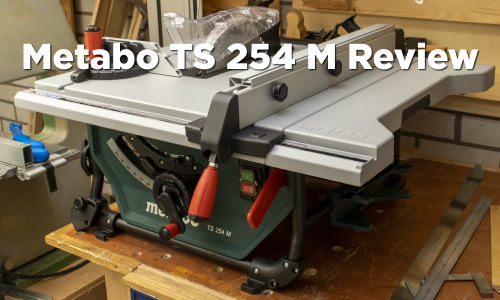
A few months ago, Metabo released their new table saw, the TS 254 M. What interested me straight away was the combination of a low price with good specs and features. On paper it looks really good with a large 254 mm blade, which is usually found on larger saws, a 1500 W motor and a solid miter gauge and fence.
I kept the TS 254 M in the back of my mind, until I decided to buy a new table saw myself recently. Previously I owned the Inca Major, which was a great saw but lacked dust collection and took up a lot of space, both things which aren’t great in a really small garage shop like mine.
After comparing it with a few other saws, I decided to take a bit of a gamble and go for the TS 254 M. There wasn’t much information available about it yet, but it looked better than the competition so I went for it.
I’ve been using it for some time now, and I thought I’d post a review of my experiences, so you can see the good and also the few bad things about this saw.
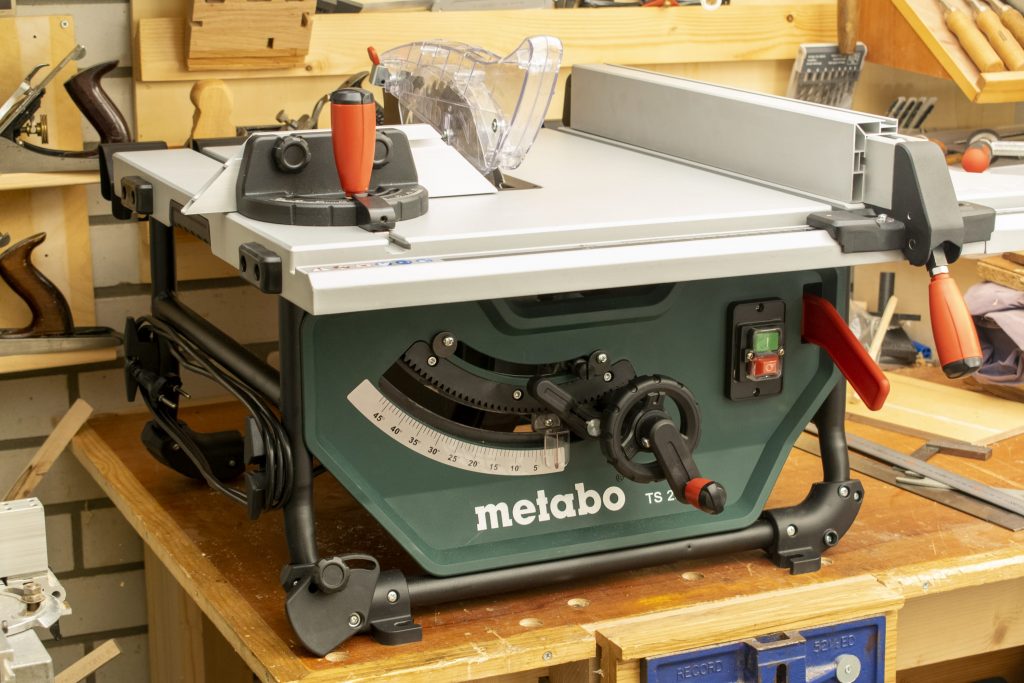
Update 02 June 2021: I’ve now also made this written review into a video. If you prefer some moving images, you can watch it below.
The Metabo TS 254 M is a relatively small table saw, but it has a large 254 mm blade. This allows it to cut up to 80 mm high, which is more than most competitors. In terms of rip capacity, it is slightly smaller than other saws with a maximum of 520 mm wide rip cuts.
Although the saw isn’t overly large, it does come in a pretty massive cardboard box:
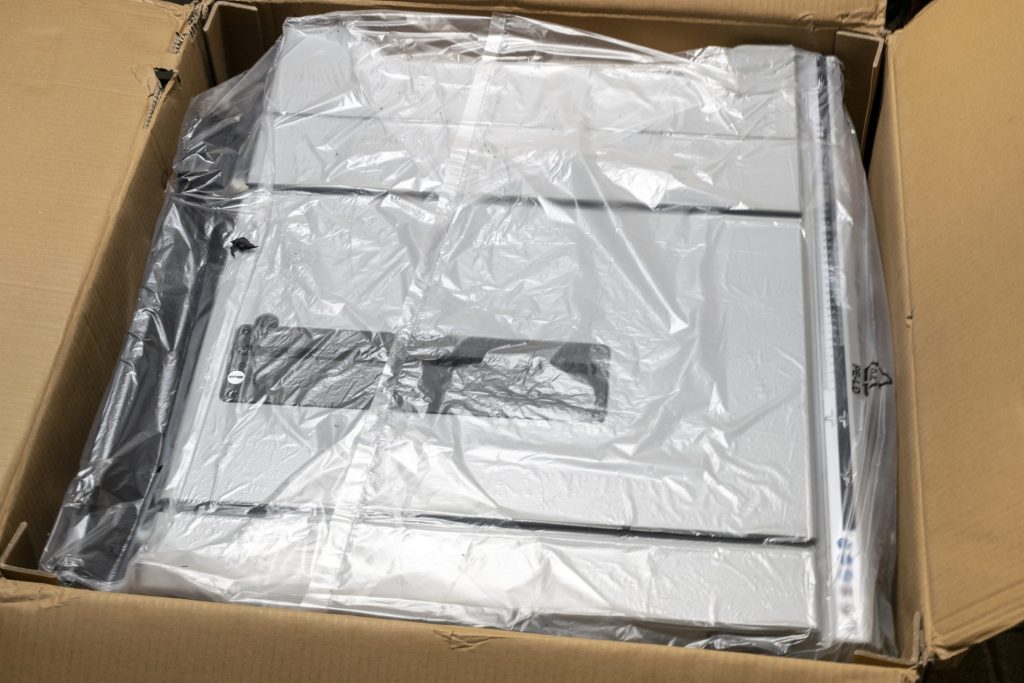
The motor has sufficient power with 1500 Watt, and the blade turns at 4200 RPM. It actually has a soft start motor, so you don’t have to worry about blowing a fuse due to a high peak in power when you turn on the saw.
Another feature is the fast motor break, which in theory guarantees the blade to stop within 3 seconds, but in my experience it usually shuts down even faster. I haven’t done a side-by-side comparison with similar saws, but I was impressed by how quickly the blade stopped.
The saw also has restart protection that prevents the saw turning back on automatically after a power outage, which is a useful safety feature.
The fence is made of aluminium and is quite heavy and feels solid. It consists of two parts, namely the main body, and a side fence (aluminium extrusion) that can be put in a low and high position. The low position helps when cutting thin pieces. On the front of the table there are two measurement tapes, black and grey, which correspond to the low and high position of the fence.
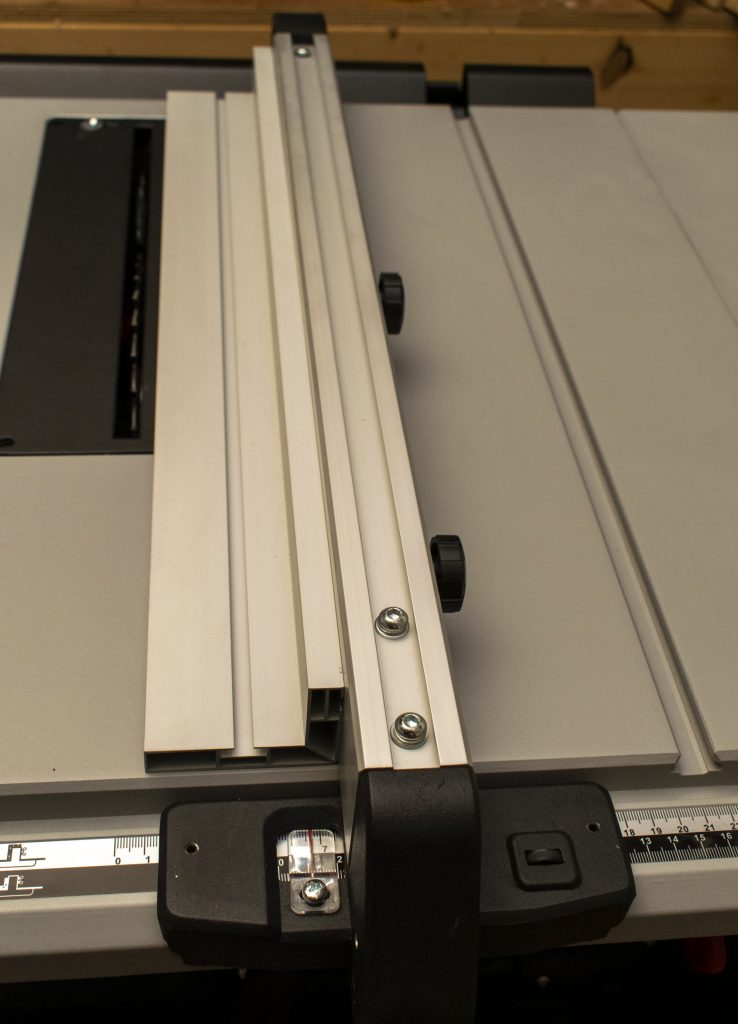
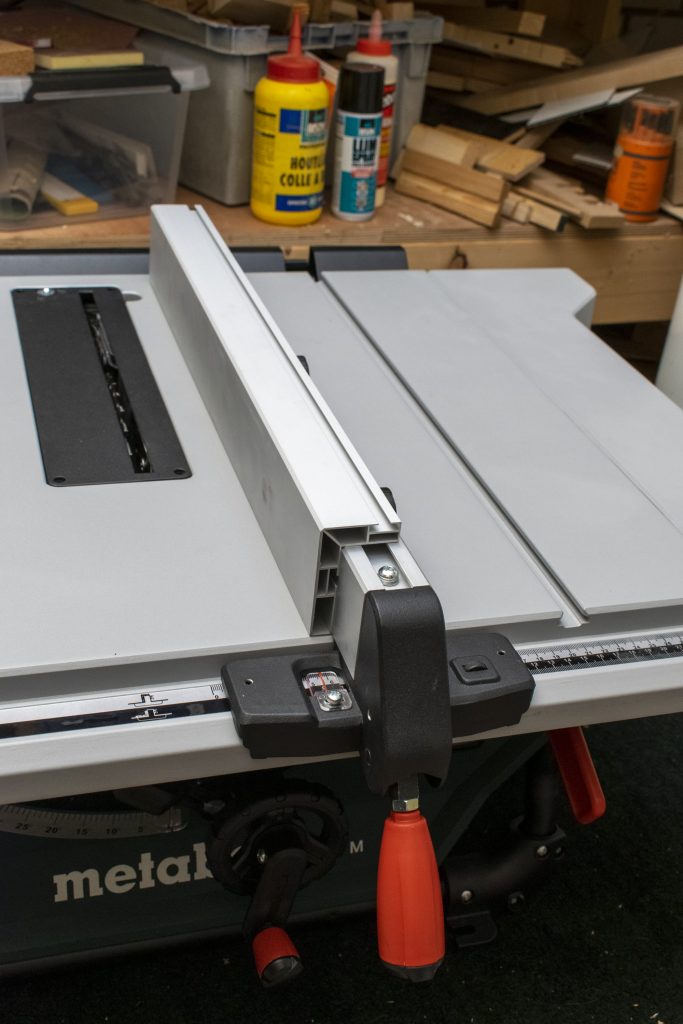
The side fence can also be slid all the way forward, so you can use it as a repeatable stop for crosscuts, which I found a pretty useful feature. There are two knobs on the right side of the fence that hold the side fence in position. All in all both the main fence and the side fence feel pretty rigid and in my case were perfectly straight.
To lock the fence in position, you simply pull the handle on the front downwards. This locks the fence both in the front and the back. I found that it did still flex a tiny bit all the way at the back of the fence, but at the front it was rock solid, so I didn’t find it to have any effect on accuracy.
What does have some effect on accuracy is the fact that the fence does not automatically perfectly align itself with the saw blade. When you lock the fence, it does pull itself slightly straighter, but you are not guaranteed to be parallel with the saw blade. This means when you lock the fence you need to make sure the fence is not in a skewed position.
This is not a major problem, but still it would’ve been nice to have the fence be guaranteed parallel with the blade. I don’t think this is really a problem of cost. My old Inca saw had an even simpler fence and it’s always perfectly parallel when you lock it.
One other interesting feature is the fine adjustment wheel. This is a little rolling wheel that you can move your finger over to tweak the fence’s position. It’s not the best system, but it works.
Miter gauges are usually one of the things table saw manufacturers save on. Even quite expensive table saws often come with really poor miter gauges. Luckily Metabo has decided otherwise! The TS 254 M actually comes with a decent miter gauge, especially for the price, although it is definitely not perfect
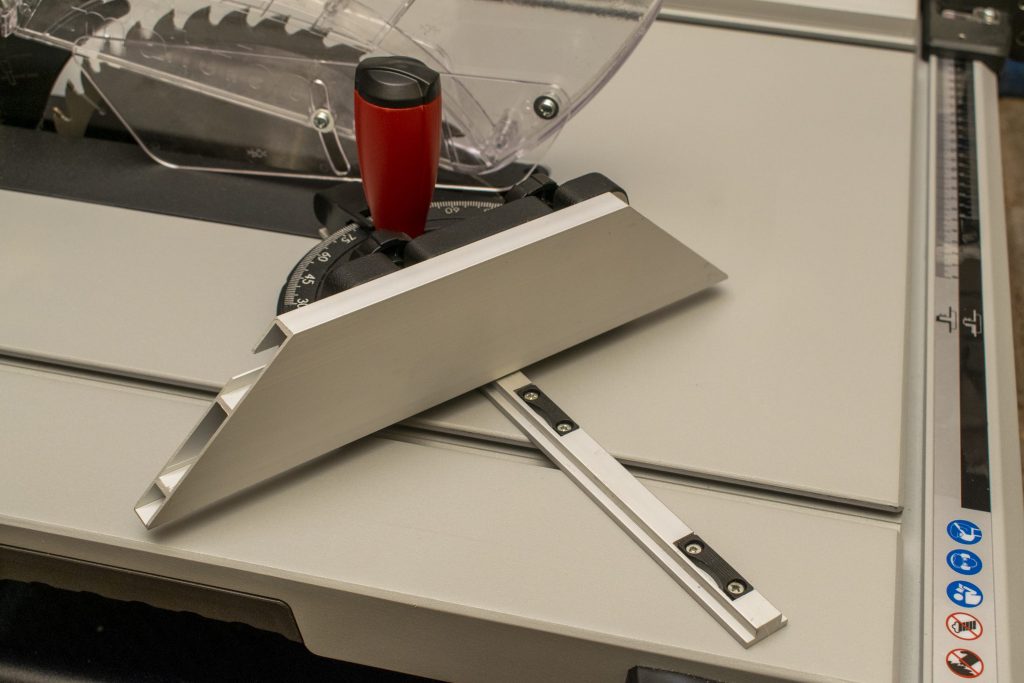
The miter gauge is made from metal and has an aluminium extrusion fence for extra support. It has 5 positive stops at 45, 66.5, 90, -45, and -66.5 degrees. These ‘click’ into position, so you can easily switch between them. The only downside is that this cannot be adjusted, so if your gauge is out of square with the blade you cannot fix it. On my saw the miter gauge was ever so slightly off (about 0.3mm over 200mm), but I corrected this with some duct tape behind the miter gauge fence. Not a beautiful solution, but it works.
Another good thing about this miter gauge is that it has two little blocks that you can adjust to eliminate any play (sideways movement) in the miter slot. These are really simple, just two plastic blocks that can be adjusted left and right and screwed down with a few bolts. But it really works and when you set them up correctly there is no play in the miter slot. This is a great move by Metabo, as sloppy miter gauges are a major source of inaccuracy for most entry-level table saws.
However, the two miter slots (left and right of the saw blade) are not perfectly straight and not identical. I had set up my miter gauge perfectly for the left slot (which gets used more often), but now it didn’t move very well in the right slot, because it was slightly narrrower. So to use that I would’ve had to recalibrate the miter gauge, which is a bit annoying. The slots are T-shaped and non-standard so I don’t think you can fit any aftermarket gauges unfortunately.
If the miter gauge isn’t precise enough for you, take a look at the optional sliding table, which can be aligned more precisely. It’s not that expensive for what you get (under €100) and greatly improves the crosscut capacity and accuracy of the saw.
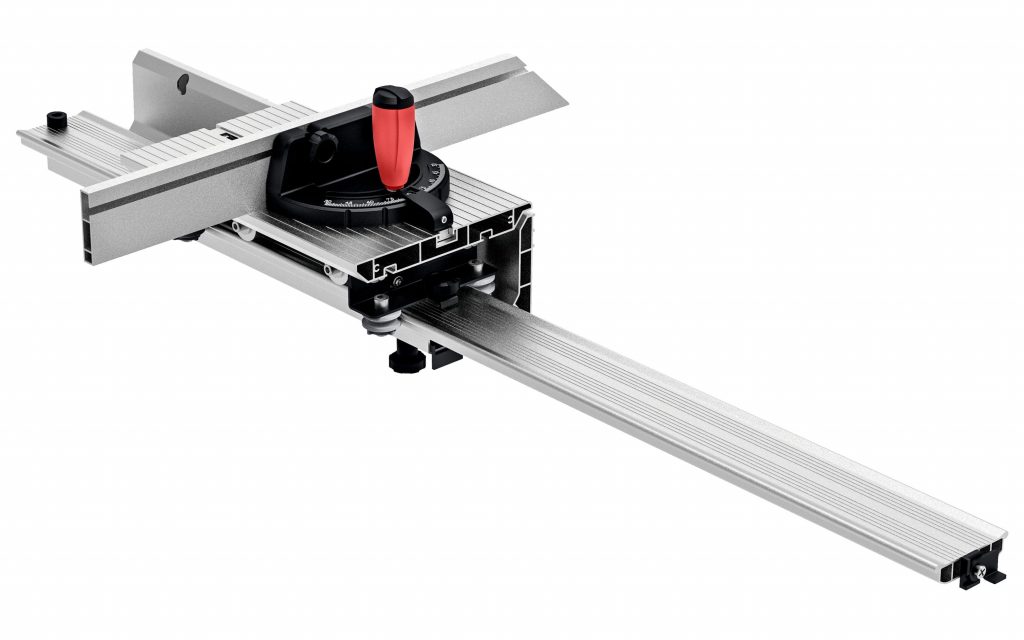
Changing the height of the saw blade is simple and works really smoothly. Simply turn a plastic handle to adjust the height. It moves slightly easier downwards than upwards, but that is normal (gravity!). There is no indication of height, but I personally have not really had the need for that, and you can always just measure the height of the blade. To retract the blade all the way under the table, you do need to remove the blade guard (but not the riving knife).
I also liked the system for changing the angle of the blade. By turning a small handwheel, the blade moves along a rack and pinion system, which makes it easier to hold the blade in place. By pulling a lever upwards, the position can be locked. There is a stop for both 45 and 90 degrees, which were set near perfectly from the factory for my saw. These can be adjusted if needed.
What I found quite clever is the system for cutting -1.5 and 46.5 degree angles. Instead of having to change the positive stops for 45 and 90 degrees, you can pull out a bolt that hits the stops, allowing it to move just a little further and make those -1.5 and 46.5 cuts. That way you can make both cuts without having to constantly adjust the stops.
There is also an indicator for the specific angle, which can be adjusted as well, but I rarely use it, because for the common 45 and 90 degree cuts I would simply look at the stops, and for any angles in between I would want to measure more precisely anyway.
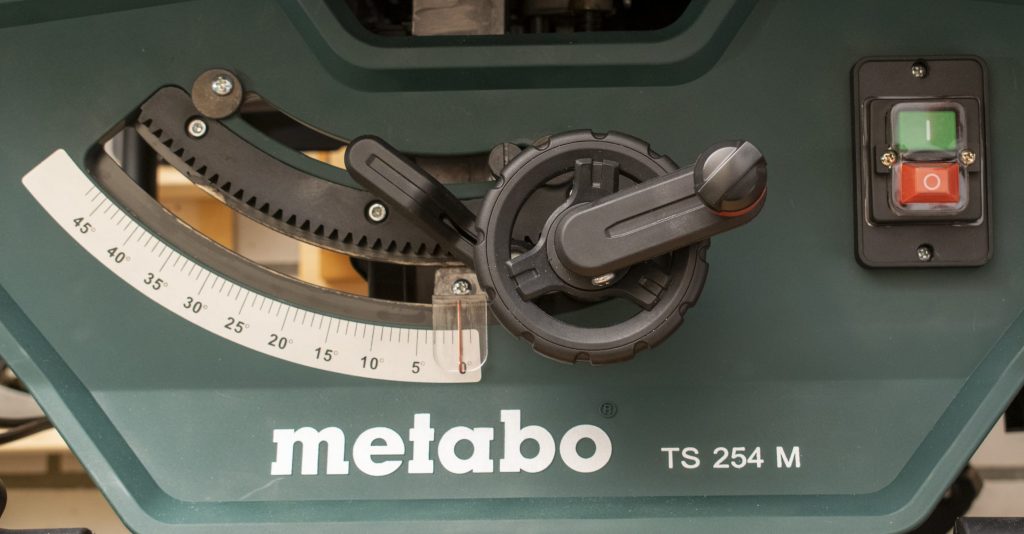
To get access to the saw blade, you simply turn a key (using the supplied spanner) and remove the insert. The insert is made from metal and feels quite solid. You can adjust the height of the insert with four screws in each corner. These screws do not hold the insert in place, only the key does, so making your own custom zero-clearance insert might not be too easy, but maybe you can replace the screws with slightly longer ones and actually use them for this purpose.
The riving knife can be finely adjusted too, both in height and in left-right position. Changing the height is simple, just pull a lever and you can slide it up and down. My riving knife was set up perfectly from the factory, but if you need to adjust its position in relation to the saw blade that can be done too, by loosening 3 screws.
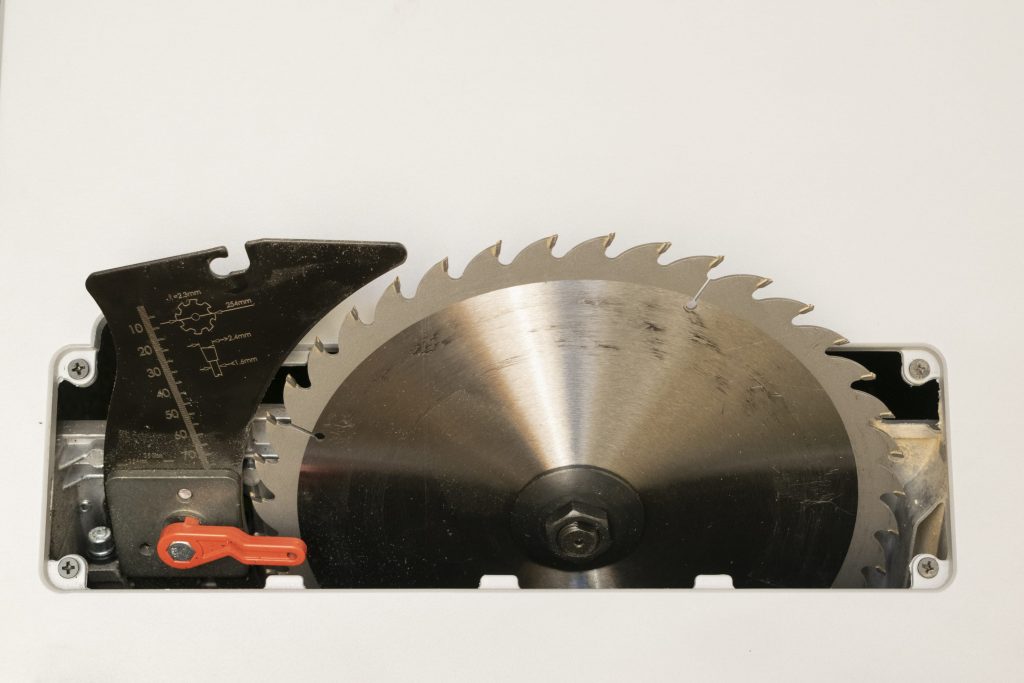
The transparent plastic blade guard attaches to the riving knife. You snap it in place and secure it with a small lever. The blade guard has a small ‘leaf’ on the left side for some extra protection. It unfortunately does not have any dust extraction. So far it has been doing a good job, but I do feel it is quite fragile so I’m not sure how long it will last.
I found the dust collection to be surprisingly good! Especially considering that there is only one dust port at the back, and none at the blade guard. Definitely don’t expect to work dust free, but the TS 254 M does not cause a big mess. I found sawdust in two main places: just below the saw, and dust shooting to the front, below where you are standing. I barely saw any sawdust to the sides or to the back of the saw.
One clever thing Metabo has done is that they added a small rubber plate around the saw blade. When you first start the saw you actually have to cut through this plate, so some rubber bits may come flying out. What this rubber plate does is that it prevents any sawdust being pulled up again from below to above the table. Because the blade cuts through this plate, the gap is really minimal. I can’t really test how much sawdust would come out without this plate (it’s not removable), but I think it makes quite a difference.
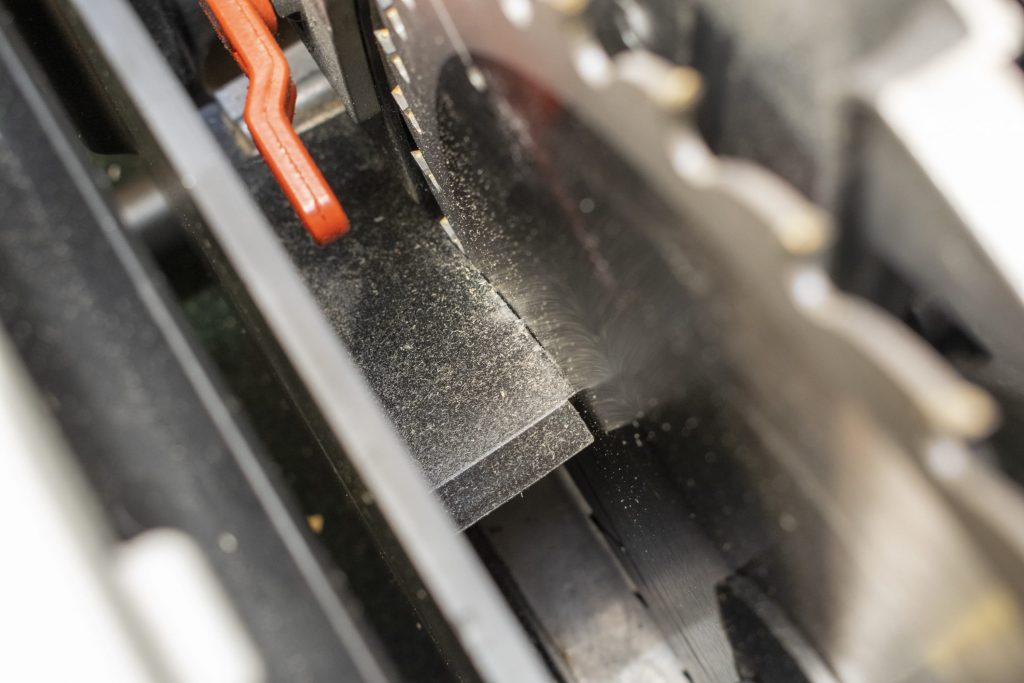
I’m using the TS 254 M purely for hobbyist woodworking, but it is also a builder’s saw that can be taken to a work site. All loose parts can be attached to the saw body so you can carry everything in one go. There is a handle on the top and there are some ‘bumpers’ on the underside to store it safely on its side. With 24 kg, the saw is still not light, but you can definitely carry it from a van to a work site without too much trouble.
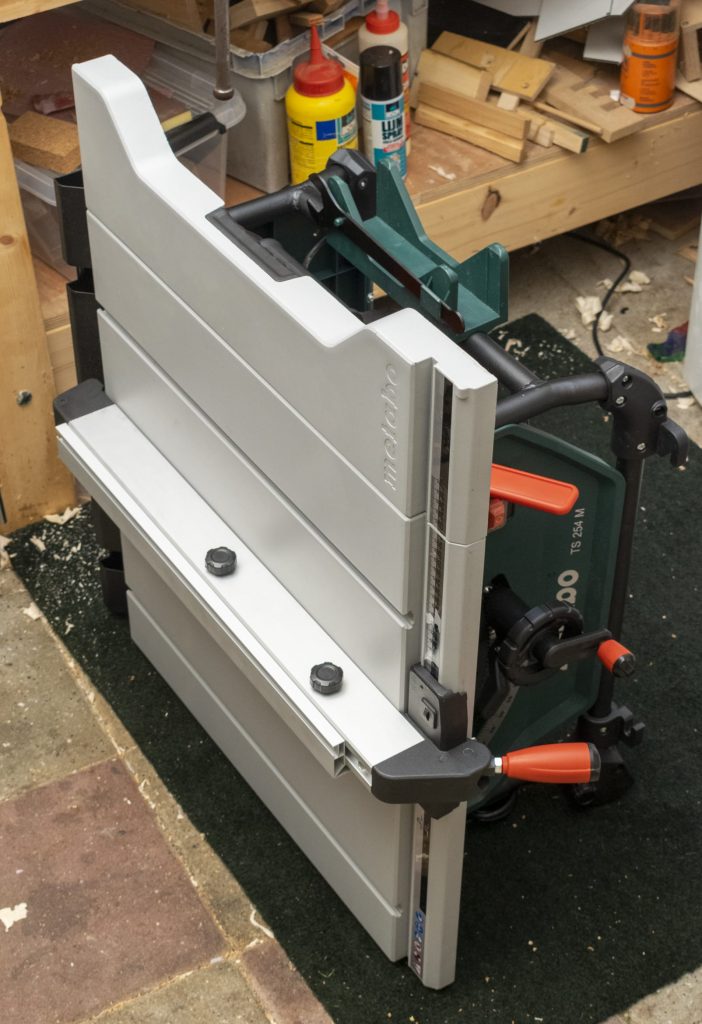
Most home woodworkers will use the saw on a table or stand, but onsite you might use it on the floor. For this purpose Metabo has added a small levelling feature to one of the legs, which you can use to stabilize the saw on uneven surfaces. It’s a nice extra touch.
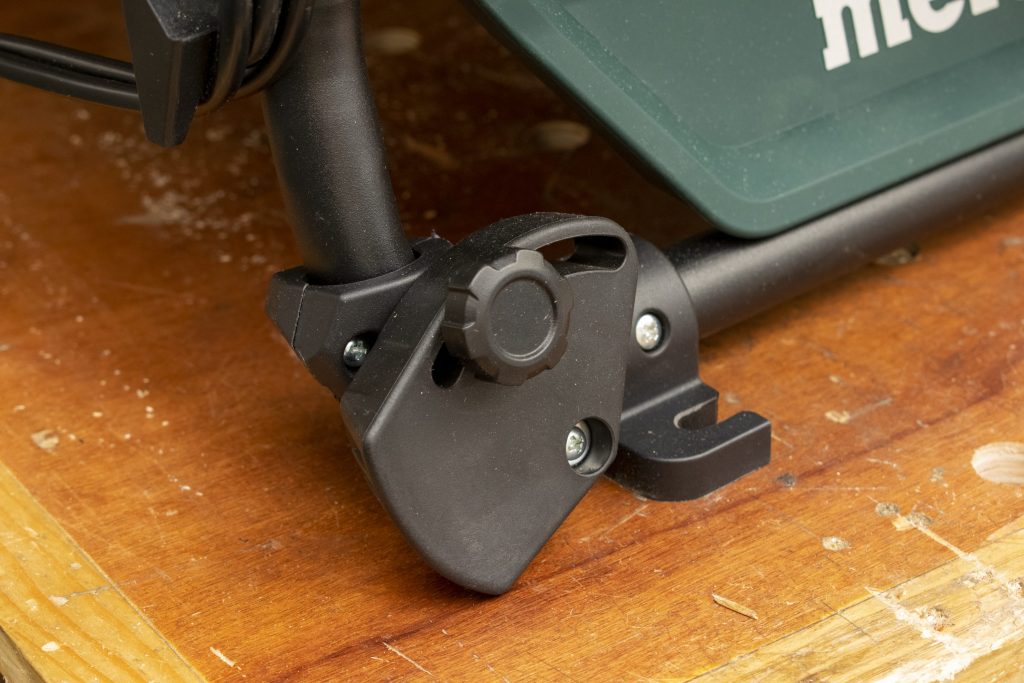
The table top feels solid and was perfectly straight. The coating does seem a little weak though, and I’ve already made quite a few scratches simply by moving the miter gauge and fence. This is purely cosmetic, and it’s hard to expect too much from a machine of this price, but still a pity.
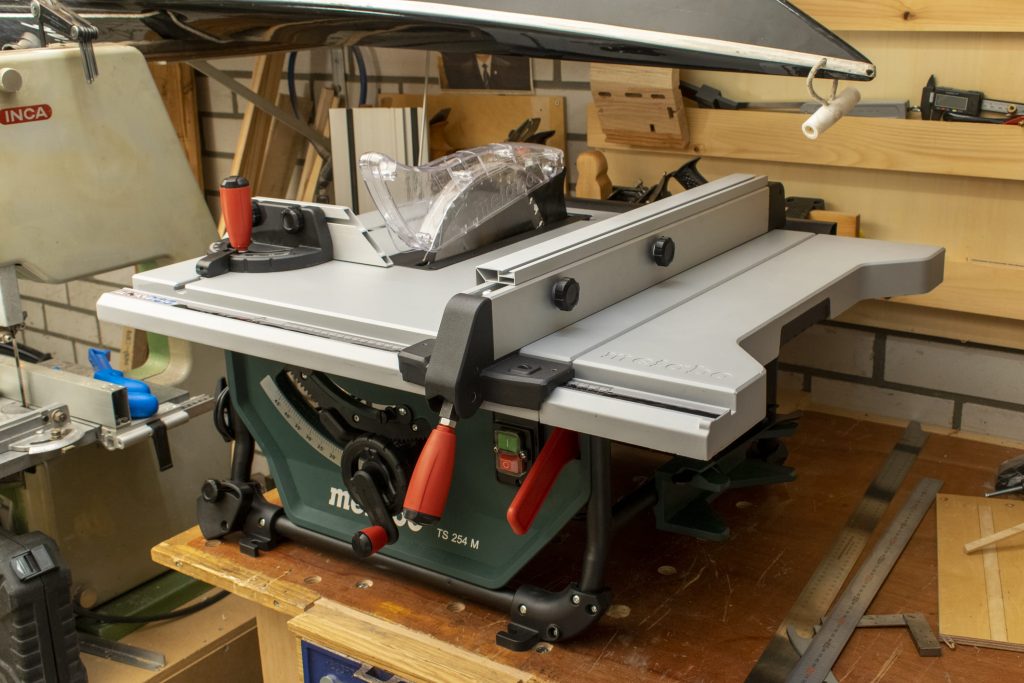
I also noticed with several bolts and screws that when you tighten or loosen them with a screwdriver, the head profile gets slightly damaged. This is because they are made of really soft metals (probably for cost reasons), so you need to be careful not to destroy the profile. I can imagine after some time you would need to replace some bolts as a result.
The finishing for all visible components is pretty good, but if you check the underside of parts, you’ll often see edges that still have cut marks, or haven’t been sanded and cleaned up. It’s simply a consequence of the price, and I didn’t find it to have any impact on the use of the saw itself.
Below are a few test cuts that I’ve made on the TS 254 M.
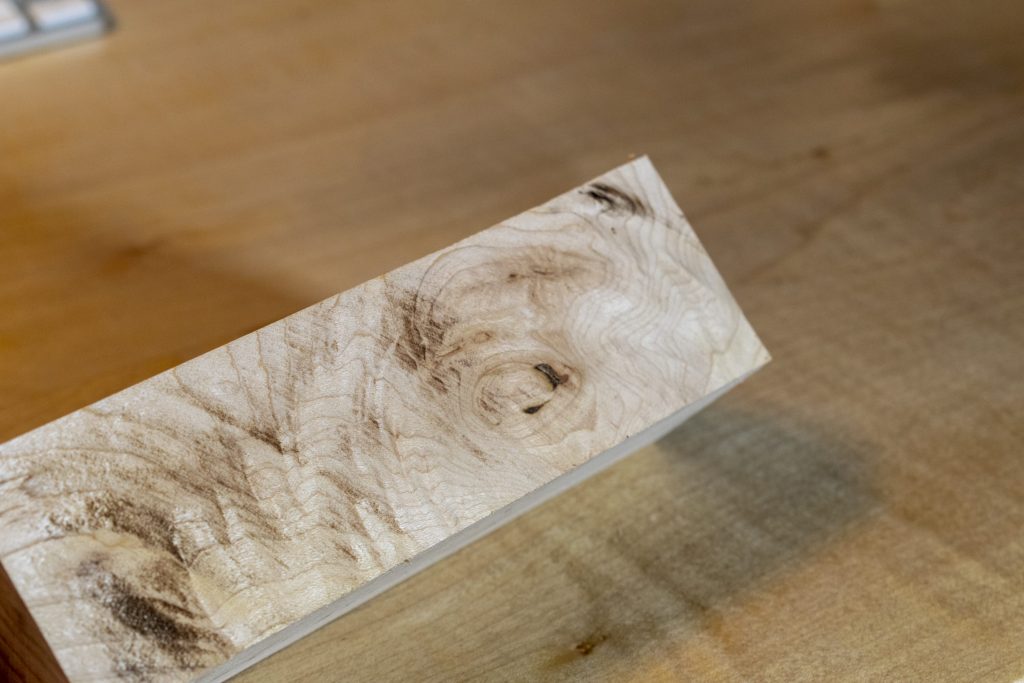
A rip cut through some really hard and knotty maple, about 45 mm thick. The saw did struggle a little bit with this piece, and even left some burn marks, but the result was still perfectly straight and actually pretty smooth.
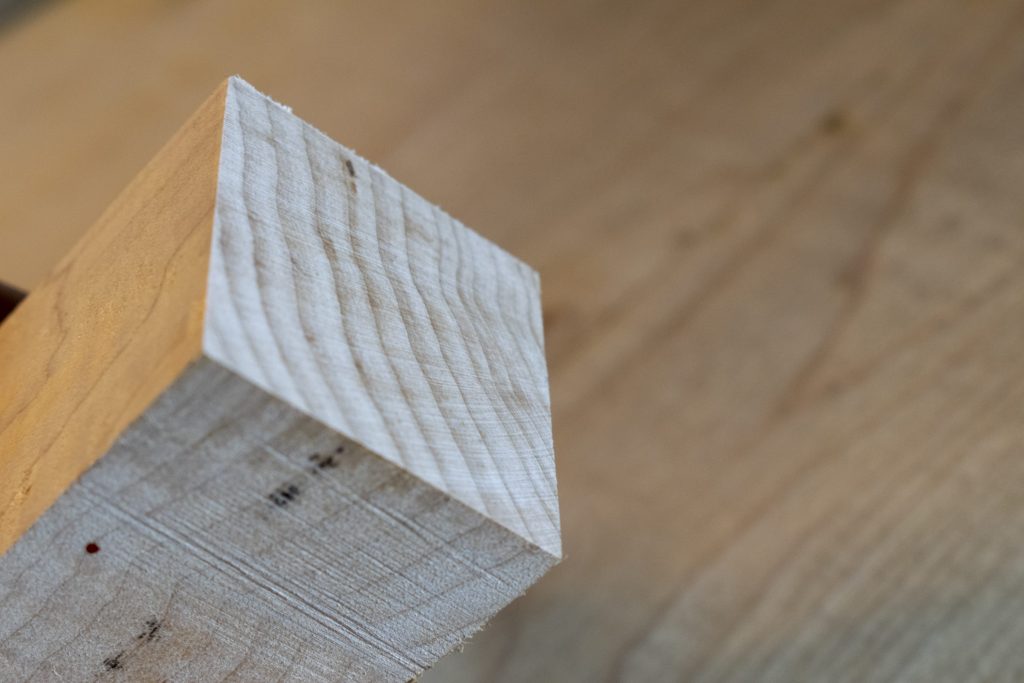
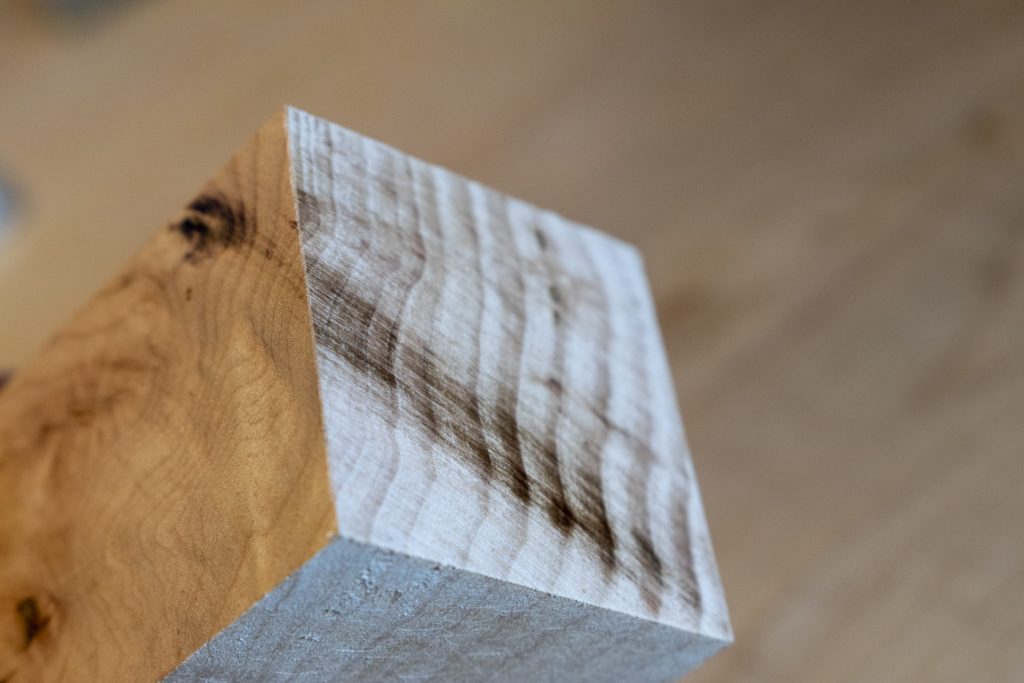
I’ve also done some crosscuts on the same piece of maple, and it would also leave some burn marks every now and then. The smoothness was impressive, as it feels about as smooth as when it’s just been planed with a freshly sharpened blade.
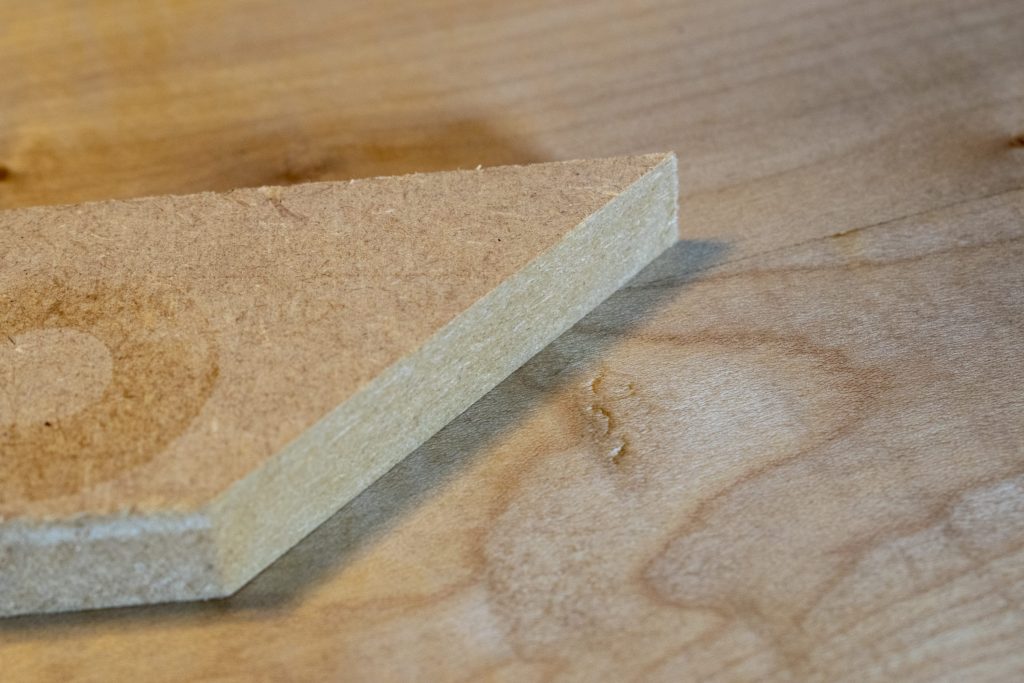
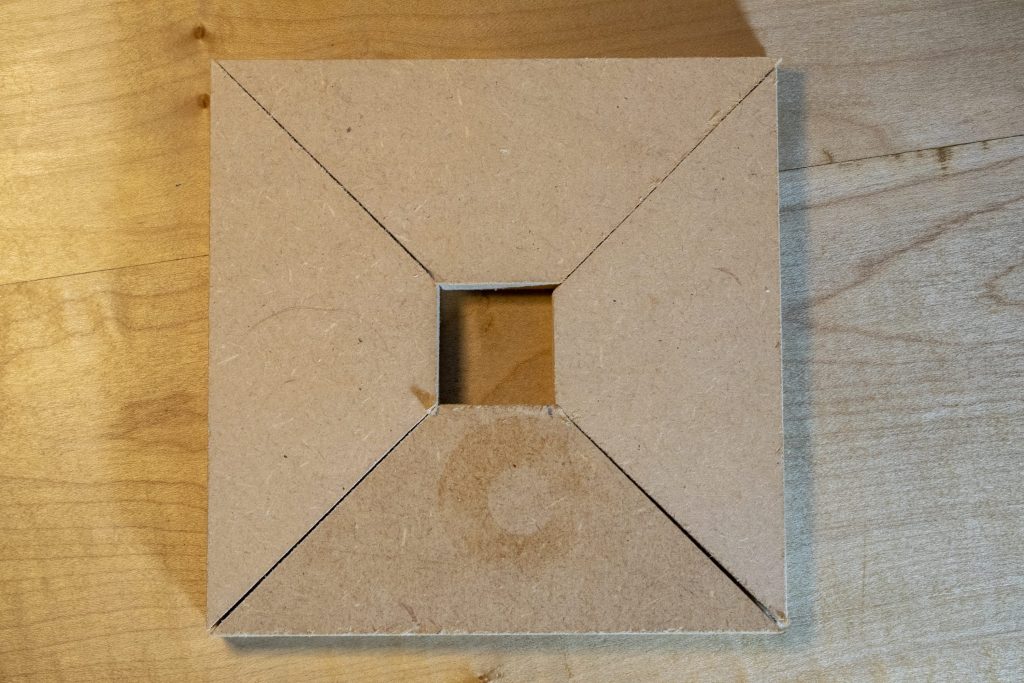
I’ve also done a few 45 degree crosscuts with the miter gauge. Unfortunately the miter gauge wasn’t set up perfectly and they didn’t line up all the way. It gets pretty close, but for perfect picture frames I don’t think this is the right saw. Maybe if you use my earlier method of adding some duct tape to the miter gauge fence, and play around with the thickness to find the sweet spot, you could get a perfect 45 degree cut, but not out of the box.
Overall, I’m impressed by the quality of the cuts of the TS 254 M. All cuts were perfectly straight and generally left a really smooth finish, especially on crosscuts. Rip cuts did have an occasional saw mark, but it also depends on how fast or slow you feed your stock.
All in all, I’m quite pleased with the Metabo TS 254 M. It has many strong points, and improves on some of the weaknesses of other entry-level table saws.
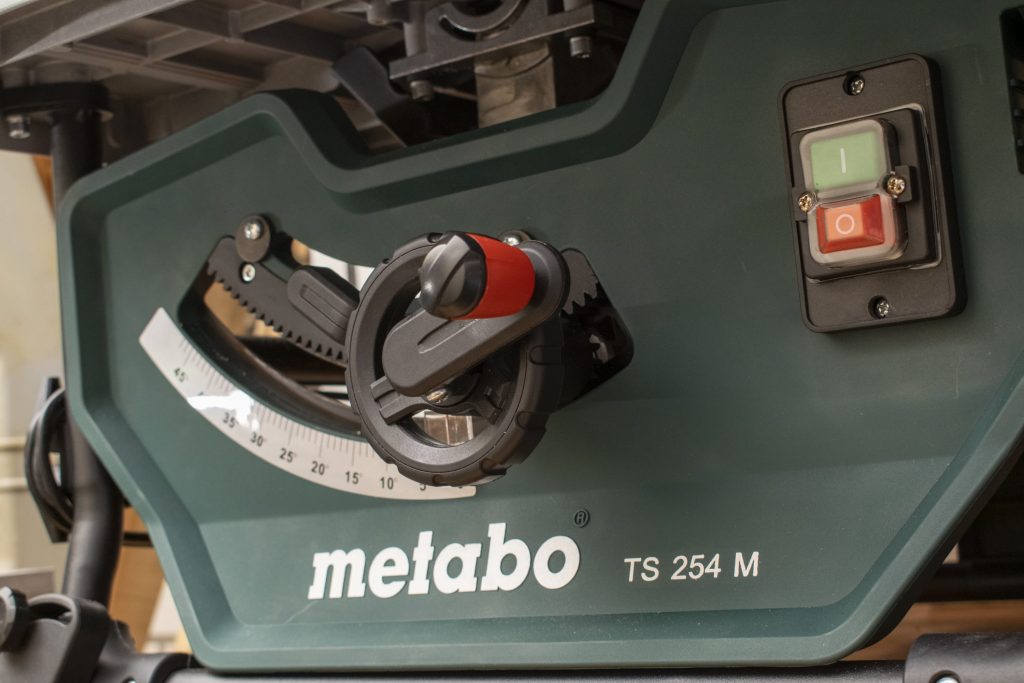
The miter gauge is better than most other saws in this range, but you may need to do some DIY fixing to make it perfectly square. The fence does not automatically lock itself parallel to the blade, but it comes pretty close.
The positive stops on the miter gauge are very helpful, as are the accurate stops for the blade angle, and the clever system for cutting -1.5 and 46.5 degree angles. The TS 254 M provides sufficient power, and has an extremely clean cut even with the standard blade that comes with the saw.
It may not be the perfect table saw, especially if you require absolute accuracy, but for many users it will be precise and powerful enough. Given the low price, I think Metabo provides excellent value for money.
You can find the Metabo TS 254 M for prices as low as €325 at certain European shops if you’re lucky, but €360 is a more realistic price with most mainstream stores. These are a few online places that sell the TS 254 M:
(These are affiliate links)
I’ve also written an article comparing the Metabo TS 254 M with the Bosch GTS 635-216 and DeWalt DW7485, which you can read here.
© Machine Atlas 2025
Hello ,many thanks for the review.
Had searched for some time for a decent review or even a video ,but nothing was really convincing or honest about the product.
I have ordered one just before i found your review anyway as i really need one for work ,and the dewalt is out of my price range,the bosch jts didn’t convince me,amd the metabo was the only one i could get my hands on a the moment .
Once again thank you for the honest review and tips about the product. I purchased the ts 254 m .
Hopefully it will last me a few good years. I am a site carpenter and it is a tool i really can’t do without this days.
Regards.
Hi Nuno, thanks for the kind comment. Glad you found my review helpful. Let’s hope Google picks the article up soon, so people can find it a bit more easily!
Rob
The issue with the fence not always locking parallel can be reduced by reducing the tension of the rear clamp. This allows the front clamp to pull up tight and square before the rear clamp engages. Manual explains how to do it.
For the miter fence the adjustment shims would not stay in place. The countersunk locking screws are the wrong choice for this duty. I fixed it with machine screws that can actually grip the shim.
The mounting block for my riving knife was out of square so it could not be set parallel to the blade in both planes. Fixed this with a shim made from alu foil.
Hi Rob, I want to thank you too for the review. It’s just impossible to find anything about the TS254M on the internet. Your article is a blessing!
I want to buy the TS254M for hobby woodworking, and I will surely build a workbench around it to make it sturdier and with a larger top surface.
I’m pretty much convinced to buy it, but I read something I really don’t like in the review: miter slots are not standard and are different from each other. Can you please tell me about their entrance dimensions? Maybe I won’t find any Incra jig, but I’d like to understand if I could build some.
Thank you again!
Andrea
Hi Andrea, thanks! I’ve checked the dimensions of the miter slot. It’s kind of a cross shape. T-shape, but on the bottom there is also a small groove. Bottom groove: ~11.2mm, main groove: ~19.9mm, top slot: ~12mm. You could definitely make your own miter gauge. The difference between the two slots (left/right) is quite marginal, it was more of a small annoyance than a big difference. But you can’t expect precision engineering at this price I’m afraid.
Hope that helps!
Hi, and thank you for the thorough review. Did you have a chance to look at the lift screw? On the (older?) non “M”-versions the screw seems to be very fine and prone to problems (see https://machineatlas.com/machines/metabo-ts-254/). Would it be possible to have a look at the part?
Hi Marco, this is a picture of the height adjustment screw mechanism, as far as I know on the old TS 254 it was solved and it was only an issue on earlier versions:
Awesome review, very detailed. Just a question, do you know if the saw can take a stack of dado blades?
Thanks Rob. Might need to find something else in that case, but figuring out if the saw will take a stack is such a headache – the info isn’t there.
I’m 99% you can’t use a stack of dado blades. I just checked the arbor, and with a normal blade on it, there is about 3mm of unused thread left on the arbor. So with a stack of dado blades you wouldn’t be able to properly put the washer and nut on.
Hope that helps!
Hi Rob
Many thanks for the review that included some very useful tips. I am busy trying to set mine up but the blade alignment in relation to the mitre slots is out by half a millimetre at the rear. This could be why your mitre angles are a tad out too. Most saws have the ability to adjust the blade angle in relation to the top surface and therefore the mitre slots. Please tell me I can do this with the 254 m as well? Can’t seem to find the info anywhere, if it is possible! I like to setup the saw with the slots, fence and blade parallel for safety reasons and to reduce burning and the possibility of kick back.
Regards
Steve
Hi Rob
Many thanks for looking into that for me, much appreciated. It is unfortunately what I feared. I will remove the blade and re-seat it… might help. If not, I’ll aim to do mitre cuts on my mitre saw and setup the ripping fence parallel to the saw blade for those long straight cuts.
Regards
Steve
Hi Rob,
I bought myself the Metabo TS254M after seeing your review. I was not able to set the blade to 90° and after some research I found that my table top is not flat (near the insert plate).
Can you please confirm if your table has the same issue?
I’ve taken some image to show how of my top really is:
– https://ibb.co/LPhpLhM
– https://ibb.co/y89FjR1
In the images you can clearly see the light shining underneath the ruler.
I’m looking forward to hearing from you.
Thanks.
Hagen
Hi Hagen, I’ve checked my version and I do have a little gap on the right side, but not as big as yours. My table slopes a little bit upwards towards the right side of the table, but near the insert it’s quite straight.
With this type of saw, I think you will never get a perfectly straight table. But in your case the distance is quite large.
You could try finding the 90 degree point by simply making test cuts and adjusting until you get the result you want. Then you can adjust the stop to that. That will depend though on whether or not the results are repeatable. Stock of different width may not give 90 degrees because of the variation in your table top. But it’s worth a try at least.
Otherwise you could consider returning it for a new one with a straighter table top.
Hope that helps!
Hi Steve,
I’ve just checked and I can see no way to change the blade alignment. The riving knife can actually be aligned with a few hex bolts, but the blade itself cannot. You’d have to change the angle of the entire block that holds the motor and saw blade, and that is simply bolted onto the table. So I cannot see any way to adjust this.
Unfortunately that seems to be a limitation of a cheap saw like this.
Hope that helps!
Hi Rob,
Great job you did here with this review, thank you so much!
I consider buying this table saw, and potentialy fit my router on the extension on the right of the blade. Could you kindly share how many cm the table extend? My router base is quite large….
Thanks again for your thorough review.
Hi Rob,
Thanks for double checking, much appreciated. I will look for the picture online.
I will rise the budget up a bit and choose between Metabo 254, Dewalt7485 or Bosh GTS 10XC…
Have a nice day, regards,
Hi Rob,
Many thanks for your quick reply and the measurement! My router has 16cm base so it will be too short indeed. I will check the bosh, the Dewalt, and the TS254 (non M).
Or simply build a separate router table at the end!
Have a good week ahead!
Hi Antoine, apologies, I made a mistake. The distance is actually 15 cm. But I guess that’s still not enough for your specific router. Good luck with the table saw choice!
Hi Antoine, thanks. I’ve checked and the gap between the tables when fully extended is 15 cm. It might be a little small for a router, but I’ve seen a picture of someone who made it work, so it might be an option.
Hope that helps!
I have some issue with the riving knife, seems like it can’t square precisely with the blade and the guides. Blades tilts a little on his axis.
Having read through all of your reviews and camparisons with this saw i think it might be the one for me. A Dewalt would be nice but i cant justify the price. This will be my first!!
Ive found this saw for £300 which i think is a good price?
It is the similar price to the Rage 5s (which was a possibility before reading this). Obviously the Rage comes with a stand. Is there a comparison or are we talking different class all together?
Hi Chris, £300 definitely sounds like a good price for the TS 254 M. I can’t really speak for the Rage’s quality as I haven’t used it in person, but there are quite a lot of mixed reviews of the machine and it doesn’t seem to have a very high build quality. That said, it might do the job just fine, but with the Metabo your odds of getting a solid quality machine are probably much higher.
Hope that helps!
Hello Rob and thanks for a thorough review.
One simple question only. In your opinion, is the saw too noisy, less noisy, or in par with other saws?
Thanks.
Hi Ajax,
I don’t have other jobsite saws (like DeWalt of Bosch) to compare unfortunately. But compared to my old Inca saw it is a little bit less noisy. I’d expect it to be about the same as other saws of this type. Only if you switch to an induction motor powered saw will you get a reduction in noise.
Still, I do not find it extremely loud as long as you wear some hearing protection.
Hope that helps!
Based on your positive review and the answer on the lift mechanism, I picked up a TS254M today. First impressions are great, the build seems to be solid enough for my work. The miter fence is very wobbly though, and adjusting the fit with the plastic parts doesn’t seem to work. Can you show us how you did this?
Never mind, found out the solution myself. The adjustment pieces have slightly elongated slots for adjustment, but for some reason it clicked back into the original position as soon as I tightened the screws. Solved my ‘problem’ wedging a thin piece of plastic between the piece and the T-bar.
It’s a bit finicky, but you have to push the metal bar to one side, and then the black block to the other side of the groove. If you put your fingertips behind the black block you should be simultaneously pushing the bar to the right and the block to the left. Then screw it tight when in position. I can make a photo/video at some point if it’s helpful.
Can the blade height be locked on this saw?